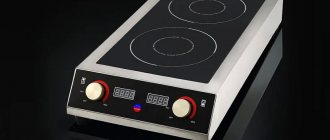In 2016, the development of television technology brought LED-backlit TVs to the peak of popularity; they are called “ice TVs.” Also today in stores you will find television receivers with OLED-based screens.
LED TVs are television receivers in which the screen is built on a liquid crystal matrix (LCD) backlit by LEDs..
The liquid crystal matrix is abbreviated in English as “LCD” (liquid crystal display). And previously, devices with such screens were called LCD TVs. But for the liquid crystal screen to work, it needs a backlight, and for the first few years a CCFL fluorescent lamp was used for backlighting. Then light-emitting diodes (LEDs) began to be used to operate the backlight. And now TVs with liquid crystal displays are called “LED TVs”, which is the same as “LCD TVs”. The differences in these names are only in the form of backlighting; all other parameters and operating principles remain the same.
As of 2014, all companies stopped producing LCD TVs backlit by a fluorescent lamp. Models are available with liquid crystal screens and LED backlighting. And today such television receivers constitute the most widespread and affordable segment of televisions. Plasma models are already leaving the market, there are only a few companies left that continue to produce plasma TVs, and these are just a few new models in 2014, and these are not flagship models. But devices with OLED screens (screens based on light-emitting diodes) belong precisely to flagship models, and their price does not yet allow these TVs to be transferred to the mass category.
Ice TV what is it
Although the spelling of LED is similar to OLED, it means a completely different technology.
Liquid crystal LED TV, what does it mean, is a device using a different backlight system compared to conventional LCD models. And if OLED (Organic Light-Emitting Diode) means that the screen consists of organic light-emitting diodes, then LED (Light Emitting Diode) is the use of diodes to illuminate the matrix of a liquid crystal television receiver. This was done more from a marketing point of view. In fact, it was not a new screen technology, just a different type of backlight. But this name for televisions has been preserved and is used today.
If conventional LCD TVs use a cold cathode lamp, the same fluorescent (fluorescent) lamps (Cold Cathode Fluorescent Lamps, CCFL), then LCD LEDs use light-emitting diodes. As you know, LCD screens on TVs consist of cells (pixels) with liquid crystals and, depending on the position of the crystal in the cell, transmits light or not. This creates a glow on the screen.
The quality of the LCD matrix determines such parameters as static contrast, black level, viewing angles, refresh rate, response time. There are such technologies for producing liquid crystal matrices for TVs: TN, IPS (S-IPS, IPS-Pro, P-IPS, AH-IPS), VA/MVA/PVA, PLS.
Parameters such as brightness, color rendering, color gamut, and dynamic contrast depend on the backlight. Although it is more correct to consider the matrix + backlight system in the TV and measure the parameters for it.
Manufacturers claim that the use of LED backlighting can increase:
- brightness,
- contrast,
- image clarity,
- color scheme.
The energy consumption of LED TVs is also reduced by about 40%. Also, ice TVs do not use mercury, which is used in fluorescent lamps, which affects the environment.
Indeed, modern ultra-bright LEDs can provide high brightness of the display image.
The contrast increases and the concept of dynamic contrast is introduced, when the brightness of the LEDs is adjusted locally for different areas of the screen, and due to this the dynamic contrast indicator increases. At the same time, the level of static contrast of the TV remains the same, it depends on the display matrix.
The black level is also improved by adjusting the glow of the diodes while watching a video. In a dark scene, the backlight level decreases and the screen becomes darker, and hence the black level improves.
But as for increasing the color gamut of the TV, we need to consider everything in more detail.
Differences between LED and conventional LCD
When using lamps to backlight the matrices, it was impossible to adjust the backlight of individual areas of the screen. This led to the fact that the contrast of LCD screens was not high enough to compete with plasma or even picture tubes that were still alive at that time. Therefore, we came to the decision to use LEDs to illuminate the matrix. At the same time, it became possible to adjust the backlight in individual areas by adjusting the brightness of individual LEDs.
This is where the advantages of LED backlighting come from compared to a conventional fluorescent lamp:
- improved screen brightness,
- contrast,
- color rendering,
- and energy consumption has decreased by up to 40%.
Due to the small size of the LEDs and the overall thickness of the LED TV body, it is smaller than others.
Differences in backlighting between CCFL and LED
White or composite LEDs
Technologically, the backlight of the display in an LCD TV is provided by LEDs. For this purpose, white diodes are used, the light from which falls on light filters and produces blue, green and red colors. This type is called WLED.
To improve the color gamut, they first began to use three types of LEDs as backlight: red, green, blue. This technology is called RGB LED.
But using such technologies it was not possible to obtain the required spectrum of light. And the color gamut was not sufficient for use in UHD TVs. To solve this problem, new types of LEDs in TVs were invented.
Composite LEDs combine blue and green into one and coat it with a red phosphor (GB-R), or alternatively combine red and blue and coat it with a green phosphor (RB-G).
Detailed information about the differences in WLED, RGB and GB-R LED backlighting.
Quantum dots in LED TV
A completely different technology for changing the WLED backlight was proposed by Nanosys.
Quantum dots in a TV replace some of the diodes, in this case red and green. All that remains is the blue LED, which generates a stream of light both to excite the quantum dots and to operate the blue sub-pixels on the screen. And the flow of light onto the red and green sub-pixels is formed by quantum dots.
Ice lighting methods
To improve the image quality on the TV screen, local dimming technology has appeared, according to which LEDs are controlled by groups of several diodes. The local dimming system has several disadvantages:
- Poor color uniformity in the image, that is, bright and dark spots are noticeable in areas where the backlight is brightly turned on and off.
- Colored halos appear at contrasting transitions.
- Image detail disappears in dark areas.
These shortcomings are difficult to determine from a regular video image on a TV screen, so today the local dimming method is widely used in models with LED backlighting.
You can also divide LED TVs according to the way the LEDs are arranged: Direct and Edge.
Direct is when the diodes are located evenly behind the screen, in the form of a matrix.
Edge is when they are located around the perimeter of the screen together with the diffuser panel. With such an arrangement, it is impossible to make effective local dimming using the local dimming method.
With the Direct method, you can get a more uniform backlight compared to the Edge method, but the thickness of the TV and power consumption will increase due to the increase in the number of LEDs. Ultra-thin TVs (thickness can be less than 3 centimeters) can only be achieved by using the Edge diode arrangement.
As of 2015, LED TVs have won the competition over plasma TVs, and OLED panels cannot yet match the cost of LED models. Therefore, in 2015, LED devices occupy all the positions in the TV lineup of all global manufacturers. Only a few manufacturers have decided to release OLED TVs, with LG especially taking the lead here. So when buying a TV this year, you will probably buy an LED model.
Which LED TV to choose?
LED TVs are the undisputed leaders both in terms of sales and price-quality ratio, so you can make your choice from the most popular screen models with similar backlighting and a 42-inch diagonal.
SHARP LC-40LE830RU
This is a representative of the Quattron family, fundamentally different from all other manufacturers in the colors of the matrix. LEDs are traditionally located around the perimeter of the body, but the color scheme contains not only traditional colors (red, blue and green), but also additional yellow, which makes the image more natural. This is a Sharp exclusive feature.
Frame rate – 200 Hz, digital tuner for all popular formats, LAN via Wi-Fi and twisted pair (and Skype support, but the camera will have to be purchased separately). You can watch videos in MKV format, although not all types. A flash drive or external HDD must be formatted as FAT or NTFS, but the Blu-Ray or DVD format is not supported. There is a Time Shift option - recording to a flash drive or USB drive with delayed viewing.
The only drawback is that the processor sometimes does not handle complex color transitions correctly, which is not a problem for dynamic scenes.
SONY KDL-40EX521
An interesting model that lacks the Smart TV function, but has a built-in browser, YouTube, and Skype (a proprietary camera with a built-in microphone must be purchased separately). The device is equipped with sensors, one of which evaluates the light level and automatically adjusts the brightness, and the other detects the absence of spectators and also automatically turns off the device after a certain period of time. The built-in player has limited functionality.
The TV simply has no direct drawbacks, although there is a peculiarity: when the dynamic adjustment mode is turned on, the brightness seems excessive, but when the dynamics are turned off, low-light scenes look much more pleasant.
LG 42LW4500
This model is the cheapest member of the 3D Cinema family. Horizontal rows of pixels on the screen emit polarized light—even ones for the right eye, odd ones for the left. Such an image is normally perceived by the naked eye, and at the same time creates a 3D effect when using proprietary lightweight glasses with passive polarizers. In this case, the image does not flicker or overlap, no batteries are needed.
However, for such ease of use you will have to come to terms with two small drawbacks:
- reduced resolution, because the image is actually created through a line;
- suboptimal contrast.
The built-in intelligent brightness control system is designed to smooth out this barely noticeable flaw.
The TV is equipped with a player that easily reproduces the MKV format and digital broadcast standards.
PANASONIC VIERA TX-LR42U3
Integration into the world of modern communication technologies is not the most impressive: Skype is not available, a USB video camera or keyboard cannot be connected either, although it is possible to access weather and news sites thanks to the Viera connect service. There is no 3D mode at all.
These shortcomings are commented on by the quality, which is the best of all the models offered in this review. Aesthetes simply have nothing to complain about. All colors are completely natural, and the movement of any objects looks absolutely natural. This is facilitated by a built-in camera designed to eliminate blurring and flickering of the image.
TOSHIBA 40TL838R
The most affordable copy of a number of models designed for viewing 3D films through special “shutter” glasses. It is assumed that the consumer either already has such glasses or can easily buy them separately. This is a justified marketing ploy.
The hardware is quite modern:
- digital tuner for analog and digital TV popular formats;
- network card with an RJ-45 connector (for Wi-Fi you will have to buy a special dongle);
- Smart TV function.
However, the main feature of this model is playback from external media, that is, flash drives and plug-in disks. The proprietary image optimization algorithms used create an amazing picture without blur, areas with unclear colors and other artifacts. This becomes especially noticeable when watching videos in “heavy” formats like MKV with a file size of 40 GB.
In addition, the viewing control system is well thought out - right from the remote control, you can rewind the recording with one touch, mark the necessary moments (to instantly return to them), and so on.
Plasma TVs
Plasma TVs consist of a series of cones filled with gas. If you apply voltage to it, plasma is formed. A phosphor is applied to the walls of the cones, which converts the ultraviolet glow of the plasma into radiation of a certain color - red, blue or green.
Interesting! A plasma panel is a matrix of gas-filled cells, each of which is coated with a special phosphor, and their glow occurs due to the formation of plasma.
As a result, any of the possible shades is formed. A distinctive feature of plasma TVs is their high energy consumption and heavy weight.
Due to the technology, the problem of partial or complete burnout of pixels arises when a static picture is displayed for a long time - the phosphor on the bulbs burns out. Plasma TVs were at the origins of thin TVs. They are characterized by a fast matrix response and high contrast, so you get a bright and rich image.
Currently, the popularity of plasma panels is declining; they have been replaced by LCD and LED TVs.
- deep and rich colors;
- low black level, such TVs produce black color as close to ideal as possible;
- high contrast;
- almost complete absence of matrix response time - this means that plasma is excellent for dynamic images, i.e. for films;
- wide viewing angles (170 degrees);
- high price;
- It is undesirable to include a static image, photographs, for example, for a long time. As we already mentioned, this harms the health of the pixels.
Main characteristics
Screen resolution. Determined by the number of pixels that form the image in width and height. The higher this parameter, the clearer the image and the more different details you can see on the screen.
LED-TVs mainly have Full HD (1980x1920 pixels) and HD Ready (1366x768 pixels) resolution. These are the most popular video formats at the moment. Some premium models have 4K UHD resolution (3840x2160 pixels).
Almost all 4K UHD TVs support HDR. This is an extended dynamic range format that allows you to depict a picture as close to reality as possible.
Screen covering . There are matte and glossy. With a matte finish, the image is softer. Viewing angle is limited. There is no glare when exposed to sunlight. If the coating is glossy, then the picture on the screen is very bright and contrasting. Visibility becomes poorer in bright sunlight.
Functional connectors . Usually there are standard ones: HDMI output, Ethernet output and USB connector for watching video from a flash drive or hard drive. The latest models have a D-sub video port. It involves connecting a computer to a TV.
Sweep frequency . An indicator of how many frames of a film are shown per second. It is measured in Hertz and can reach values up to 960 Hz. For 3D TVs, the frequency can be even higher. The recommended range of values so that the image does not blur and pictures do not overlap one another is 100−200 Hz.
LCD TV
The phrase LCD display stands for “Liquid Crystal Display”, the synonym is LCD display. It consists of an LCD matrix, which, in turn, consists of two plates. Between them are liquid crystals. In addition to the matrix, the display design includes a backlight. Classic LCD TVs and monitors use CCFL backlighting - these are so-called cold cathode fluorescent lamps.
The backlight lamps are located at the end of the light-scattering layer of the matrix. The principle of operation is that liquid crystals located between two polarized plates change the polarization of light when a voltage is applied to them. The polarized plates between which the crystals are located have mutually perpendicular polarization. This means that light would not pass through these plates if there were no liquid crystals. Thus, by smoothly changing the polarization vector, you can change the intensity of light transmission through the matrix.
To obtain a color image, a color filter is applied to the cell. This is called a subpixel. There are red, green and blue subpixels. A group of subpixels of three colors is called a pixel. This part of the display is called a matrix because it consists of millions of such pixels.
The distinguishing feature of televisions in this group is their significantly lower weight and power consumption than plasma panels. Unfortunately, they have a lower viewing angle and contrast than plasma. The black color in LCD TVs is usually not completely black, but something between dark blue and dark gray tones. The response of the matrix is also lower than that of plasma panels. Manufacturers are using various technological tricks to improve the quality of LCD TVs.
- Relatively low cost;
- Great for displaying photos and other static information;
- Low power consumption;
- Service life up to 75,000 hours.
- High black level (closer to dark gray);
- Low contrast;
- Great response time.
Black level is measured in NT or nits, which is equal to 1 candela per 1 square meter of area. The lower the black level, the blacker the color.
What is LCD TV
Still mysterious to many, the abbreviation stands for Liquid Crystal Display, that is, what is popularly called a liquid crystal screen. This design involves the use of liquid crystals placed between transparent polymer plates. The color image in this case is formed by applying a voltage, which allows the crystals to change their ability to transmit light waves of different lengths. You need to understand that crystals are not capable of producing light, so they are usually illuminated using fluorescent lamps placed behind the matrix.
LED TV: advantages and disadvantages
Basically, LED TVs are LCD TVs. But instead of CCFL lamps, they have LEDs in the backlight. Due to this, energy consumption is further reduced. There are several options for LED backlighting:
- The placement of LEDs along the edge, the so-called Edge option. It is no different from CCFL backlighting. High contrast cannot be achieved. LEDs located around the perimeter of the screen shine on the light-diffusing glass, after which the liquid crystals transmit or do not transmit light. The problem is that closed (turned off) crystals still allow some light to pass through. Therefore, it is not possible to achieve depth of black;
- To solve this problem, we developed LED carpet backlighting for displays. This technology is called differently depending on the manufacturer, for example Full HD LED or LED pro. This technology allows for improved illumination uniformity, and individual diodes can dim their brightness to increase contrast and achieve a blacker color than with previous technology.
- acceptable, and in expensive models there is good image contrast;
- good color rendering;
- low weight;
- low power consumption;
- the use of LED backlight eliminates the high-voltage inverter for igniting lamps from the circuit. And it most often failed in CCFL LCD screens;
- LED TVs are thinner than LCD: the thickness of modern models reaches 4 mm.
The only significant drawback is the high cost of LED monitors and TVs, but recently this problem has been solved - there is a tendency for prices to decrease.
Advantages and disadvantages
LED TVs have low power consumption
. New technologies are emerging, so LED TVs are becoming cheaper, and their advantages can be appreciated by many buyers.
Among the positive qualities noted:
- small body thickness. This equipment weighs little, so there are no difficulties with its placement. If desired, the TV is mounted to the wall using a bracket. And thanks to the laconic and universal design, LED devices will look advantageous in any interior;
- high contrast level. In models with Direct LED backlighting, this parameter is configurable;
- low power consumption;
- diversity. In addition to classic models, designer ones are also available: in the form of a photo frame, mirror, with a curved screen;
- long service life. Explained by the resistance of diodes to burnout;
- contrast and clear image. The response time in such panels is reduced, so even dynamic scenes look smooth. As for viewing angles, in this parameter LED devices are close to plasma panels;
- environmentally friendly technology. No mercury is used in the production of television panels.
There are also a number of disadvantages:
- dark and bright spots with activated and deactivated backlight. The fact is that Local Dimming technology controls a group of diodes, so colored halos may be visible in a contrast image;
- high requirements for signal quality. If you play a low-resolution movie on your LED TV, it won't look the best. The image is “stretched”, which reduces detail;
- LED models are 40% more expensive than classic LCD devices.
Now they produce OLED devices, the matrix of which is assembled from organic light-emitting diodes. They are responsible for the formation of the finished image.
OLED TVs are even thinner than their LED counterparts, they have wider viewing angles and improved color rendition. In order for the black color to be a “deep” black, the separate diode simply does not light up. This allows you to increase the contrast significantly.
But OLED TVs are expensive and have a relatively short service life. While this technology is being finalized, it is LED devices that are considered in demand.
Types of LCD and LED TV matrices
Today the popular types are:
- IPS are currently installed mainly in LG TVs of the low and mid-price segment 3-6 series and Philips 4 and 6 series, as well as on Panasonic. With its help, the developers managed to achieve large viewing angles. Its disadvantage is a fairly high black level (approximately 0.16 nits) and a long response time;
- S-PVA, manufactured by Samsung. Installed on Samsung, Panasonic and Sony 7 and 8 series TVs. Features a low black level (from 0.05 to 0.1 nits). Viewing angles are smaller than IPS;
- UV²A - this type is manufactured by Sharp. Installed in top Philips and Sharp models. Their viewing angle is between S-PVA and IPS, and the black level is the lowest and deepest - from 0.02 to 0.06, which is comparable to the black level of plasma panels.
Comparative characteristics of LCD, plasma and LED TVs
For greater clarity, let's compare the distinctive features of each type of TV - LCD, LED, plasma.
- Screen size. Previously, due to the design features, plasma panels had large diagonals; currently, a number of diagonals start from 42″. LCD and LED TVs can be manufactured in any size. For example, mobile phone screens have been manufactured using these technologies for more than 15 years;
- Contrast. In the first place in this category are plasma panels, LED in second, and LCD in third, although for liquid crystal displays the type of matrix plays a big role in the image;
- Depth of black. This value is related to the contrast of the image; plasma technology is also in the lead, and in liquid crystal displays, LED TVs with carpet backlighting and a UV 2 A matrix have the maximum black depth;
What is the difference between an LCD and an LED TV?
LED technologies are gradually replacing liquid crystal technologies, since the former are more efficient and economical. This means serious energy savings and a better screen image. Although the differences between these LCD and LED approaches lie only in the way the screen itself is illuminated.
Everything is moving forward. Modern films are produced using the latest technology. Therefore, in order to fully immerse yourself in the atmosphere of the new film, it is better to watch it on LED-TV.
Today, LED-backlit devices are the best solution in terms of image quality and equipment cost. Modern solutions in TVs of this type make it possible to compete with expensive plasmas (PDP), confidently displacing the latter from the market.
True OLED TVs are very promising. In these panels, LEDs are truly the imaging unit. But these models are still expensive and only pay for themselves with very large screen sizes.
Tips for choosing
All types of TVs are good in their own way; to choose a model that suits your needs, you need to decide what is your priority. The comparison above and these five tips from the experts will help you with this:
- If high contrast and deep colors are important to you, a plasma TV is perfect;
- For those whose TV works almost 24 hours a day or for use in public places, such as cafes and bars, an LED TV will be the best choice: they have a long service life and low power consumption;
- If the budget is very limited, but you want a large screen, then it is more profitable to purchase an LCD TV;
- Pay attention to the ability to play multimedia from a USB flash drive - this way you can save on purchasing an additional player;
- Access to the Internet via TV will make it easier for older people to learn new technologies, and will also be useful for those who have small children to play cartoons on Youtube.
Important nuances when choosing a TV
Separately, you need to dwell on how to choose a LED TV. Despite the seeming obviousness and simplicity of choosing the type of device, you need to understand that LEDs are different, and in order to choose the right one, it doesn’t hurt to understand what qualitative differences characterize such TVs and how they are expressed.
The main factors that you should pay attention to when choosing an LCD TV are:
- The principle of screen illumination with LEDs
This is directly related to how the technology is implemented. It is impossible not to mention how LCD TVs differ from fundamentally different technology - OLED (organic light-emitting diodes).
The difference between models with OLED displays is that the LEDs here do not illuminate the matrix with white light, thereby illuminating the image, but rather form the image themselves. The matrix of such a display consists of many LEDs, each of which emits the desired color of a certain intensity. This fundamentally affects not only the quality of the picture, which is a level higher here, but also the cost, which in turn hinders the mass distribution of this technology. In addition, OLED displays have a much shorter service life, approximately 2-3 years, which is also a limiting factor for its distribution. At the same time, the service life of LED TVs is about seven years.
At the moment, OLED technology is a distinctive feature of the premium segment of TVs, and here each buyer, based on his budget, decides which to get - LED or OLED.
- Illumination Uniformity
Depends on the number of LEDs. Of course, you won’t be able to count them, but before purchasing you should pay attention to the degree of uniformity of the screen’s glow. It is advisable to check this not on a beautiful high-resolution picture, but on solid colors - then it will be easier to see highlights. However, this practically never happens on TVs from famous brands, even in the budget segment; it is mainly the manufacturers of Chinese brands who are guilty of this.
High-price TVs use so-called carpet backlighting, which is characterized by the fact that the LEDs are located immediately behind the display and are evenly and fairly densely distributed over its entire area. In addition to uniformity, this method also allows you to control the brightness of the glow in a particular area on the screen. In practice, this allows you to reduce the intensity of the glow in those areas of the screen where you want to achieve deeper blacks. It must be said that this is a very uncommon technology, and not all brands implement this approach well. The most commonly used schemes are those in which LEDs are placed in two garlands, one each at the top and bottom of the display, or in several such garlands, symmetrically distributed directly behind the screen.
- Glow brightness
This determines how well the screen will be visible in daylight. Many people probably know what it’s like to watch a movie or a program when the entire picture is illuminated by the sun. Therefore, it is worth paying attention to this point if you plan to use the TV in brightly lit rooms, or if it will be located opposite a window. In any case, the brightness, if it is excessive, can be reduced. Guided by these points, you will already know exactly how to choose the right LED TV.
What are LED TVs
An LED TV is a device that is a TV receiver with a liquid crystal screen. The matrix is equipped with a special backlight from a set of LEDs. Explanation of the abbreviation LED - “Light Emitting Diode”. From a technical point of view, it would be more correct to call such devices liquid crystal with LED backlighting. However, Samsung was the first to launch such a device on the market under the name “LED TV”. Other manufacturers adopted it, so it became common.
Choose a good option
Often, when we go to a store, we choose a device primarily by size and price. But there are many other factors that also need to be taken into account.
So let's figure out which option to choose - led or lcd, what possibilities are hidden behind the abbreviation, led TVs - what does this actually mean, why have they become so popular lately.
The essence of this question is to find out which TV is better, but this approach to comparison is fundamentally wrong, since LED denotes the matrix backlight technology, and LCD is, in fact, the matrix itself, inside which the image is formed. A similar, erroneous attempt to compare is that an inexperienced buyer is trying to understand what is better - LCD or ice.
Partially understanding the difference will help to understand the terminology. The abbreviation LCD comes from the English Liquid-Crystal Display, which means “liquid crystal display”, and LED (light emitting diode) is translated as “light emitting diode”. Therefore, it is inappropriate to compare a screen and a light bulb, especially since the concepts of lcd and led are related, do not contradict each other and coexist perfectly in most modern models. Moreover, LCD matrices with backlighting other than LED are becoming increasingly rare.
Such a false comparison in the minds of ordinary people did not arise by chance - it is the result of the planting of a marketing idea. It was she who promoted LED as a fundamentally different type of technology, leaving behind the scenes that, in fact, it is only a fundamentally different type of backlight, which replaced the fluorescent backlight in the same LCD TV.
Undeniable advantages allow ice lighting to differ from fluorescent lighting, otherwise it would not have become so widespread. After all, LED TV backlights have not only supplanted fluorescent ones, they have practically driven them out of the market, not least because LEDs are cheaper to produce.
Another undeniable advantage in receiving the title “best” is environmental friendliness: LED TVs, or rather LEDs, do not contain mercury, which fluorescent lamps cannot boast of.
A very strong argument in favor of purchasing LED equipment is the presence of much higher performance characteristics compared to models with the old type of backlighting. One of the differences is that LEDs burn longer and do not dim during operation. As a result, such a TV works without loss of image quality. And the service life of the device is a significant factor in the choice.
LED backlight
Nowadays different types of such devices are produced. They differ in the type of LEDs used and the order of their location in relation to the screen. By lamp color:
- Single-color (White LED). A budget option. It does not have the disadvantages of fluorescent backlighting and creates an image with a similar color gamut, but not as contrasty.
- Multi-colored (basic RGB LED color triad). The color palette is expanded due to the LED brightness control. The number of semitones has been increased. To support this technology you need a powerful GPU. The model will cost more and consume more energy.
- Mixed. Blue LED backlights and a special film with green and red quantum dots. This technology reduces the device's power consumption.
We found out what LED backlighting is on a TV. In addition to the color of the lamps, it differs in their location. There are two options:
- Directly behind the LCD matrix. Direct backlight type Full or Direct LED. These models are cheaper than Edge, but not as thin. With a high level of contrast. They have white and multi-colored LEDs.
- Along the perimeter of the LCD matrix. Edge LED backlight type. LEDs can be located on one (bottom), two (side) or four sides of the screen. Thanks to this, manufacturers produce models less than 1 cm thick in these white LED devices. Budget models made using this technology have a drawback. They show highlights along the edges of the screen. In addition, they have a low contrast level.
Characteristics
There is a huge variety of models from different manufacturers on the market. They differ in price depending on the parameters they have. To make it easier to choose a model based on your budget when purchasing, learn to understand at least the key characteristics that an LED TV has:
- Permission. There are several options: Full HD, HD Ready, Ultra HD. The latter is considered the best.
- Smart function. Thanks to this option, you can access the Internet directly from the device. There are models with and without a built-in router.
- Sweep frequency. Shows how many times the image is updated per unit of time.
- 3D image function. If you plan to watch films in this format, then choose from two display technology options: active and passive. Compare both options in the store and determine which is more comfortable for your eyes.
- Matte or glossy screen. The first one does not have such a large viewing angle, but the second one has glare.
Advantages
An LED TV is nothing more than an LCD screen, but improved. LCDs used to use CCFL cold cathode fluorescent lamps as the light source. They were replaced with LED lighting. This freed liquid crystal devices from their characteristic disadvantages. Thanks to LED technology, TVs have become thinner (especially Edge models). They are environmentally cleaner and more energy efficient, do not contain mercury, and do not require specialized disposal. Advantages:
- more contrast image compared to other technologies;
- maximum screen viewing angles;
- rich and natural colors;
- consumption of a relatively small amount of energy;
- display high definition signals;
- thin body.
3D
Do you need 3D images? If you consider yourself to be a lover of modern technology, then a TV with a surround image will interest you. All 3D devices use 1 of 2 existing 3D imaging techniques: active or passive. Active technology uses glasses with an active shutter, which closes the eyes one at a time.
Glasses with liquid crystal lenses also interact with the TV device, using Bluetooth or an infrared port. This option is considered expensive, but at the same time it has its drawbacks. There is slight flicker. Add to this the additional cost of purchasing batteries.
The passive option divides the picture into two different polarizations. Due to different lenses, one eye will see the image from one polarization, the other from another. There is no need to purchase batteries. The main disadvantage is the halved image resolution. To choose a TV with 3D wisely, you need to look at two technologies in the store at once. Tilt your head, change your focus, move away from the TV. This is the only way to choose the best option for yourself.
LED TVs
There is a huge range of panels from different manufacturers on sale. You can easily choose a small budget device or a huge one with many additional functions and capabilities. Some panels can be used not only for watching movies, but also for playing games on the console. Find out which models from well-known manufacturers are the most popular.
Models from this manufacturer have proven themselves well; they work reliably for a long time. If you are interested in this brand, pay attention to this option:
- Model name: Shivaki STV-48LED15;
- price: 24,000 rubles;
- characteristics: black, screen diagonal - 48 inches (121 cm), refresh rate - 50 Hz, resolution 1920x1080 dpi, video in Full HD format, sound power - 16 W, four digital tuners, 3 HDMI ports, 1 USB connector for viewing multimedia files from external media, has a recording function, child lock option, weight – 11.5 kg;
- pros: fits well into any design, can be placed on a shelf or mounted on a wall, reasonable cost, high-quality image;
- cons: no Smart TV, Wi-Fi, 3D capabilities, surround sound, few functions, poor response to the remote control, inconvenient menu.
This company has a lot of TV options: plasma, LCD, LED. They are distinguished by good quality and affordable prices. You may be interested in the following option, budget but worthy:
- Model name: TCL LED32D2930;
- price: 14500 rub.;
- characteristics: diagonal 32 inches (81.3 cm), resolution 1366x768 Pixels, brightness 240 cd/sq. m, 16:9 format, progressive scan, 60 Hz refresh rate, Smart TV, timers, child lock, teletext, program guide, 2 built-in speakers, stereo sound power 10 W, surround sound, Wi-Fi? connectors – component, 3 HDMI, PC input, coaxial audio output, 1 USB, black;
- pros: cheap, can be hung on the wall or put on display, good picture and sound quality, bright colors;
- Cons: too fragile, cannot be used instead of a monitor.
The company's products include a huge number of LED TVs. Nowadays this one is especially popular:
- Model name: Samsung UE40MU6100UXRU;
- price: 36,000 rub.;
- characteristics: diagonal 40 inches (101.6 cm), Edge LED backlight, 16:9 format, Ultra HD, resolution 3840x2160 pixels, HDR support, Smart TV, voice control, timers, program list, channel name entry, protection from children, Russian menu, program guide, teletext, digital noise reduction, comb filter, image and sound enhancement technologies, decoder with automatic and manual settings, 2 built-in speakers, sound power 20 W, 3 HDMI connectors, 2 USB ports, Wi- Fi, Bluetooth;
- pros: natural colors, stylish design, the remote control is universal and controls all devices connected to the LED TV, connects to a mobile device, excellent picture quality;
- cons: slows down when playing very large files.
All LED TVs from this company are distinguished by high quality, durability and attractive modern design. This option will fit perfectly into a stylish interior:
- model name: Ultra HD (4K) LG 43UH619V;
- price: 32,000 rub.;
- characteristics: white, diagonal 43 inches (109.2 cm), Direct LED backlight, 16:9 format, Ultra HD available, resolution 3849x2160 pixels, progressive scan, anti-glare coating, Smart TV, input of channel names, child lock, menu Russified, teletext, program guide, Plug&Play function, dynamic scene index, digital noise reduction, comb filter, 2 built-in speakers, sound power 10 W, surround sound, 3 HDMI ports, 1 USB connector, Wi-Fi;
- pros: good image detail, detailed clear instructions, loud and clear sound, a lot of useful functions and modes;
- disadvantages: there is distortion of the picture when viewed from different angles, few applications, you often need to adjust the screen format to different types of files, inconvenient mounting on the wall.
Among the wide range of this manufacturer there are a lot of inexpensive and high-quality models. Pay attention to this option:
- model name: Mystery MTV-4030LT2;
- price: 18,000 rub.;
- characteristics: diagonal 40 inches (101.6 cm), Direct LED backlight, 16:9 format, Full HD, resolution 1920x1080 pixels, progressive scan, refresh rate 60 Hz, timers, clock, input of channel names, program list, protection against children, freeze frame, Russian menu, blue screen, shutdown when there is no signal, teletext, program guide, built-in radio, digital noise reduction, 2 tuners, 2 built-in speakers, power 20 W, 3 HDMI connectors, 1 USB port;
- pros: affordable price, convenient menu;
- cons: not very saturated colors, insensitive remote control, no Wi-Fi, poor sound.
How to choose an LED TV
Buying equipment for your home is a very important moment that needs to be approached with the utmost seriousness. It is important to go to stores with a good reputation that guarantee the quality of their products. You can either buy an LED TV or order it from an online store with delivery from Moscow or St. Petersburg to your home by mail. It is profitable to buy equipment before the holidays; during such periods, stores often have sales and promotions and offer excellent discounts. Tips for choosing an LED TV:
- Screen diagonal. This is one of the most important indicators. Many people believe that the larger the screen, the better. The optimal size should be calculated as follows: divide the estimated distance from the viewing position to the LED TV by three. The diagonal should be equal to the number you get.
- Screen resolution. The best for today, but also the most expensive, will be an Ultra HD LED TV.
- Image quality. This option should be selected based on personal preferences. In stores, as a rule, there are a lot of working TVs broadcasting the same file. Compare which one you like better.
- Screen covering. Glossy is more contrasty and brighter. However, it is not suitable for a room with a lot of sun, it will glare. Matte makes the image less clear, but is not shiny at all.
- Format. The most popular at the moment is 16:9. Suitable for watching both digital and satellite television. The second 4:3 format option is suitable for cable channels.
- Manufacturer. Buy only products from companies that have been on the market for a long time and have proven themselves well. Pay attention to reviews online.
- Settings. The more options you can adjust, the better. On some budget models it is impossible to even change the brightness of the image.
- Additional functions. Modern LED TVs are equipped with many options that are not critical: voice control, wi-fi, built-in router. Assess your budget and decide which bells and whistles you need.
- A set of functional connectors. It is better to purchase a TV that has HDMI and USB ports for connecting other devices. Check whether the connectors are conveniently located and whether access to them will be difficult.
The evolution of TVs: from LED to OLED
Let's look at what both abbreviations mean and what the fundamental difference between the two technologies is.
- LED TVs are a type of LCD panels equipped with LED backlighting instead of the outdated lamp backlight. LEDs located either at the edges of the panel (Edge LED Edge LED
) or directly behind the crystals (Direct LED
Direct LED
) illuminate the liquid crystal matrix. The matrix adjusts the level of light that leaks in, creating an image on the screen. - OLED TVs are based on organic light-emitting diodes connected into a screen matrix. They do not need additional lighting, as they emit color themselves. In practice, this makes it possible to create the thinnest displays and obtain deep black colors.
Let's consider and compare the parameters that the user should first pay attention to.
Image quality
As we have already figured out, OLED displays, due to their operating principle, are able to convey black color much better than LED. The organic LED matrix also has high contrast, but slightly loses in image brightness.
Pixel response time
In the first LCD TVs, the picture often had a “loop” when playing dynamic scenes: the pixels did not have time to “react” and change the brightness to the desired level. Now this effect is minimal, especially in top-end LED TV models, but even they have not yet reached OLED speeds. LEDs in OLED displays instantly change the brightness level to the one required, eliminating the possibility of “blurring” the image when playing dynamic scenes.
Viewing angle
Do you want to watch TV with a large group so that the image can be seen from any part of the room? OLED is more suitable for this - the display quality remains stable even at large viewing angles. However, it is worth noting that the best LED models also cope well with this task, albeit somewhat inferior to new technologies.
Diagonal
We will still give primacy in this parameter to liquid crystal LED displays - for their versatility and the ability to choose a device for a room of any size. Judge for yourself: at the moment, in electronics stores you can buy LED models with diagonals from 15 to 105 inches, and OLED models from 55 to 77 inches [1]. Thus, the latter are not suitable for large halls or small rooms, but LED TVs can be selected in full accordance with the size of the room.
Panel thickness and weight
Here the undisputed leader is TVs made using OLED technology: it is this technology that allows you to create the thinnest and lightest panels possible. Available for free sale are models with a thickness of 4 mm [2] excluding the stand (for example, LG OLED65W7V [3]). LED devices, although not much, are thicker - from 10 mm (for example, Xiaomi Mi TV 3S 55 [4]).
It’s the same with the weight of devices: with a diagonal of 65 inches, models with organic LEDs have the minimum weight - the same LG OLED65W7V without a stand weighs only 7.62 kg, and LED panels - from 20 kg (for example, LG 65UH5B-B with a weight of 26 kg [5] ).
Electricity consumption
LED models have an advantage, although the difference is small and largely depends on the specific model.
Life time
It should be noted that this parameter has nothing to do with the warranty period or the reliability of the system as a whole. For TV screens, the service life indicator means the time after which the screen will “burn out,” that is, lose half of its original color brightness.
When OLED models appeared on the market, many experts spoke about the extremely low service life of blue LEDs used in displays - only 15 thousand hours [6]. The screen is thus designed to last approximately 30 thousand hours (the blue color does not “work” all the time). For comparison, LED panels have a stated service life of approximately 50–100 thousand hours.
Now some manufacturers have abandoned the use of RGB LEDs in favor of white ones. This made it possible to increase the operating life of OLED displays to 100 thousand hours [7].
Thus, in terms of this parameter, the performance of both types of panels is identical and depends on the specific manufacturer and model class.
Price
If we consider the general price range, rumors about the fabulous cost of models with organic LEDs are a little exaggerated. Thus, according to Yandex.Market, OLED TVs with a diagonal of 55–77 inches can be purchased at prices ranging from 72 thousand (LG 55EC930V) to 1.5 million rubles (LG OLED77G7V) [9]. An LCD panel of the same size will cost the buyer from 26.5 thousand (Thomson T55D22SF-01A) to 1.2 million rubles (Bang&Olufsen BeoVision Avant 75) [10].
However, on average, an LED TV is much cheaper than its more “advanced” counterpart. High-quality 55-inch LCD model with 4K resolution, SmartTV Smart TV
, Wi-Fi
Wi-Fi
and a large viewing angle can be purchased for 55–70 thousand rubles (for example, Sony KD-55XE8005 [11]), while even the simplest OLED displays will cost a little more.
So is it worth comparing LED and OLED TVs: the pros and cons of the technologies?
At first glance, we can say that TVs with organic LEDs have an advantage in most parameters and are only in part inferior to LCD panels. But many indicators can hardly be called key: for example, thickness and weight are not important for all users, and not always in favor of smaller values. For home placement, the difference between 5 mm and 5 cm of TV thickness is often not critical, and the low weight, for example, will make it easier for pets and children to tip over. In terms of key parameters, each type has a couple of really serious advantages.
Features and benefits of LED TVs
When choosing the right TV model, many consumers are faced with new terms and modern technologies. For example, not everyone knows what a TV with LED technology is and what principle its operation is based on. Despite this, today this type of flat devices is most popular among buyers, so they are considered a completely familiar attribute in the home. Before you make your final choice, you should still figure out what the abbreviation LED means, how such TVs differ, and what advantages they have over other types of TV.
What kind of technology is this?
The abbreviation LED stands for “light-emitting diode”, which means “light-emitting diode” or simply “light-emitting diode”.
The essence of the technology is the glow of semiconductor materials under the influence of electricity. It has been known since the middle of the last century, but widespread industrial implementation began relatively recently. The implementation of the technology is carried out according to the following principle: behind the main screen, which the viewer sees, there are point light sources - LEDs. The light they emit passes through the screen, undergoing certain transformations along the way, and thus the final image is formed. You can see what such a screen backlight system looks like in the photo:
LED technology makes it possible to achieve the most favorable ratio of costs to quality of the generated video at the moment, which is why it is actively used by modern manufacturers.
Definition and Features
Literally translated, LED is a light-emitting diode. However, it is advisable to believe that it cannot serve as a complete definition. In fact, a modern LED TV is a representative of the long-known liquid crystal panels. The main component is an LCD matrix with many luminous dots - pixels. But if the usual LCD devices used fluorescent lamps as backlight, then the devices in question use LEDs, that is, TVs with such backlighting are more advanced versions of LCD models.
Samsung developers were the first to use this technology. As a marketing ploy, the new TVs were given the name LED TV, which is still used today.
LEDs here act as light sources, and are not the actual unit of the image being formed. Therefore, it would be more correct to call such panels LCD TV with modern LED backlighting.
What is LED on TV
The exact and literal translation of the word LED is light-emitting diode. But since this abbreviation is applied both to televisions and to all technology, the wording is rather a guide. In fact, no one invented a new TV. It’s just that in all known liquid crystal panels the backlight fluorescent lamp was replaced with an LED.
TV manufacturers are abandoning fluorescent lamps, replacing them with LEDs
The founders of the lighting method are South Koreans from Samsung. Since the diode itself does not form an image, but only illuminates it, it would be correct to call the new LCD TV with LED backlighting. But for the purpose of a marketing ploy, the pioneers called their panels LED TV. The name stuck and is still used today.
Replacing the CCFL lamp with an LED made it possible to significantly reduce the thickness of the panel and reduce power consumption.
The safety of the equipment has increased in terms of its impact on the viewer’s health. After all, they removed the lamp that uses dangerous mercury to operate. For several years now, the production of LCD panels with harmful fluorescent lamps has been discontinued everywhere.
This is interesting! How does a bathroom TV work?
Types of LED backlight
In order to understand what the fundamental feature of such equipment is, you need to understand the types of TV backlighting. Today, several systems are used; they differ in color and arrangement.
By color of light sources
- White led or single-color system (white LEDs). It is considered a budget solution, but still outperforms fluorescent lamps. LEDs are more energy efficient and do not contain mercury. As for color rendering and coverage depth, LED TVs with this type of backlight are not much different from LCDs; the difference is more significant in the next option.
- RGB or multi-color system. Their color palette is much wider. Due to this, color rendition improves. But it is worth noting that models with a similar backlight option are more expensive, which is not commensurate with the achieved effect. Such models require a powerful graphics processor, and they consume more electricity. Since such HDTVs are not affordable for every group of consumers, leading companies decide to abandon RGB backlighting and continue to search for analog technology.
- QD Vision or mixed backlight option. It is based on pure blue LEDs and a special film with quantum dots, which have green and red colors. This technology makes it possible to emit a strictly limited and tuned spectrum of optical waves. Due to this, the color palette and intensity of colors expands, at the same time, the technology, unlike RGB LEDs, is more energy efficient. A striking example of a mixed backlight option is the line of Bravia TV panels, the leading manufacturer of Triluminos Sony.
In fact, the question of using the first and second backlight options continues to find many controversial opinions. For example, the famous digital technology developer Toshiba claims that white TV backlighting is much more effective than RGB. So why spend a ton of money when you can save millions?
According to the lighting placement option
There are 2 options here.
- Along the perimeter of the LCD matrix (Edge LED). This is a one-color system (White led), which can be located on one side (most often from the bottom), on parallel sides (on the sides) or along the entire perimeter. The method of organizing side lighting depends on the size of the screen diagonal. The disadvantages of such backlighting include the edges of the TV screen and an insufficient level of contrast (compared to the second type). But this technology makes it possible to create panels only a few millimeters thick.
- Directly behind the LCD matrix (Direct LED). It is based on the uniform distribution of diodes over the entire area. In terms of price, it is more expensive than edge lighting. The main advantage of such a system is the ability to use local black dimming technology. Both white and color LEDs can be used here; they significantly improve image quality.
If you already own such a TV and have problems with the image, you may find the information on DIY LED backlight repair useful.
Tips for choosing
LED devices have become popular. After all, LED TV - what does it mean? This is high quality, convenient and comfortable to use. The advantage of an LCD TV is LED backlighting; all LED models have it. But sometimes you have to pay extra for design features and additional features. What should you pay attention to when choosing an LED TV model?
First of all, you need to decide which diagonal is best to choose. The stores offer a huge selection of different models from 19 to 58 inches. Sometimes it is not very common to calculate in inches and you have to select the size in centimeters, that is, from 48 to 147 cm. The correct choice of diagonal depends on the size of the room where the TV will be installed.
Advantages of LED TVs
These panels have significant advantages, which is why they are popular among consumers. Of the main advantages, the following factors should be noted.
- Case thickness. It is through the use of LEDs that the production of ultra-thin models has become possible. This TV can be easily mounted on the wall using a bracket;
- Contrast and image clarity. LED TV is the main competitor of other types of TVs, as it has excellent image reproduction quality and adjustable contrast levels. Recalling the shortcomings of LCD panels, when problems were observed with the perception of moving objects, it can be noted that with modern ice screens such problems will not arise.
- Energy efficiency. Energy savings are perhaps the main point that attracts many buyers. Compared to its predecessors, the LED device consumes 40% less resources.
- A wide selection of models not only in functionality, but also in appearance. Such a panel will decorate absolutely any interior without any problems. Leading manufacturers have a huge number of models, including both classic solutions and interesting shapes and colors.
- Durability. Thanks to the use of fade-resistant LEDs, TVs have a longer service life.
But the improvement of such television panels does not end there. OLED TVs , the backlight of which is based on organic light-emitting diodes, are appearing on store shelves They have an even thinner body, light weight (relative to their diagonal), a wide viewing angle, the absence of flare and glare, and excellent color rendition. However, this does not mean that other lower class models will lose demand. Innovative technologies of this format are not cheap, and the financial capabilities of most consumers will not allow having such a widescreen panel at home. Therefore, the demand for simple models of modern LED TVs is unlikely to fall in the near future. Detailed comparative characteristics of both types are given in the article about the differences between LED and OLED TVs.
L
Pros and cons of LED TVs
First, let's look at the advantages of LED TVs.
- Small body thickness. By using LEDs it is possible to create ultra-thin TVs.
- The image is contrasty and clear. Due to the reduced pixel response time, it was possible to achieve the most realistic image possible, even if there is dynamic movement on the screen. The viewing angle competes with plasma TV.
- Energy efficiency. Almost a key advantage for buyers. The device consumes 40% less electricity than its predecessors.
- Extensive model range , both in functional features and design.
- Lifetime . Due to the use of reliable and fade-resistant LEDs, the LED screen has a long service life.
- Environmentally friendly product . No mercury. Moreover, LED TV safety documentation complies with all strict global principles.
Now for the cons:
- Since local dimming technology is used to improve picture quality (LEDs are controlled by groups consisting of several diodes), TV models have the following disadvantages: the presence of dark and bright spots in places where the backlight is activated and deactivated, and colored halos are present at contrast transitions. In dark areas, picture details may disappear. Viewing angles may also be limited.
- Increased demands on signal qualityx. A low-resolution transmission on a TV will not look the best, showing all the disadvantages of the device.
- An LED screen is considered an expensive pleasure. In most cases, these TV models are 40% more expensive than conventional LCDs.
Now you know the advantages and disadvantages of LED devices.











